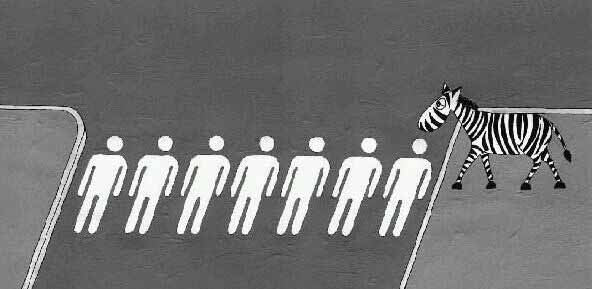This is a little pedestrian but there is slightly more to it than at first blush. We begin with zebra crossings, the originals, which are found in many parts of the world.
The crossing is characterised by longitudinal stripes (hence the term, named after the zebra) on the road, parallel to the flow of the traffic, alternately a light colour (usually white) and a dark one (painted black, or left unpainted if road surface itself is of a dark colour). The stripes are typically 40 to 60 cms (16 inches to 2 feet) wide. Pedestrians always have right of way on a zebra crossing.
The zebra crossing was first used (after some isolated experiments) at 1000 sites in the UK in 1949 (the original form being alternating strips of blue and yellow), and a 1951 measure introduced them into law. In the UK the crossing is marked with Belisha beacons on each side of the road. The beacon is a black and white pole topped by a flashing amber globe. They are named after Leslie Hore-Belisha, Minister of transport who introduced them in 1934. Pedestrians have right of way on this type of crossing; road traffic must give way to them.
The crossings were originally marked by beacons and parallel rows of studs, but the stripes were soon added for the sake of visibility.
The crossings were originally marked by beacons and parallel rows of studs, but the stripes were soon added for the sake of visibility.
Today the amber lights flash and there are zig-zag lines on the approach. Zebra crossings with bollards in the middle should be treated as two separate crossings.
A zebra crossing famously appears on the cover of The Beatles' Abbey Road album. This is a famous zebra crossing, and has even been incorporated into the current Abbey Road Studios logo. However, since the Abbey Road photo was taken, zigzag lines at the kerb and in the centre of the road have been added to all zebra crossings to indicate the no-waiting zones on either side. There are actually two zebra crossings in Abbey Road and people can sometimes be seen taking photographs of each other on the wrong one.



No comments:
Post a Comment